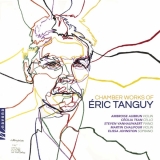Drei Ersteinspielungen und weitere ausgesuchte Kammermusikwerke zeigen den Stil der punktierten Modalität von Eric Tanguy. 1968 geboren, studierte er bei Jolas, Malec, Grisey und Radulescu in Paris. Werke des mit Preisen und Ehrungen überhäuften Komponisten werden oft aufgeführt, sind aber doch nicht überall bekannt. Der Werkkatalog mit über 100 Einträgen umfasst viele Gattungen.
In jedem der sieben zu hörenden Stücke wird eine Facette der schöpferischen Seite gezeigt. Insbesondere in Bezug auf Tonhöhen, Harmonie, Skandierung von Melodien, Rhythmus und Form ist sein Streben von der Modalität, nicht der Tonalität geprägt. Die individuell geprägte Handschrift bietet Musik, die ein anregendes und zugleich intimes Hörerlebnis bietet, das auch ohrwurmverdächtig sein kann.
Der langjährige Kontakt mit Cécilia Tsan wurde in den 2000er Jahren wieder intensiviert. Daraus entstand auf ihren Wunsch das Trio für Violine, Cello und Klavier, das in einem Satz eine quasi kontinuierliche Variation über ein kleines Motiv von sechs Noten auskostet. In der Sonate für zwei Violinen sind Doppelkonzerte von Vivaldi und Bach sowie Sonaten für zwei Violinen von Jean-Marie Leclair für den früher aktiven Geiger Tanguy der Ansatz, dieser Kombination ein heutiges Echo zu geben.
Die Quattro Intermezzi für Klavier beziehen sich auf Brahms’ gleichnamige Werke. Tanguy hat diese durch auf strenger harmonischer, melodischer und rhythmischer Arbeit beruhende poetische, einzigartige Musik zu übersetzen und dadurch neu zu zeigen versucht. Die Neue Studie für Klavier solo ist nach einem einfachen Prinzip gearbeitet, bei dem ein Anfangsmotiv durch Harmonie, Register und Dynamik umgewandelt wird. Bei der Elegie für Violine solo werden kurz und intensiv Traurigkeit und Wut über den plötzlichen Verlusts eines Freundes und Kollegen ausgedrückt.
Invokation für Cello solo diente als Wettbewerbsstück. In Abschnitten werden einzigartige Transposition eines ursprünglichen Modus verarbeitet. The Lys and the Lyre für Sopran und Cello schließlich vertont fünf Meditationen über den Tod. Mit einer reinen Melodie für die Stimme und einer einfache Gegenmelodie für das Cello hat Tanguy diese Aufgabe umgesetzt.
Mit allen Interpreten, nicht nur Cécilia Tsan, verbinden Tanguy langjährige Beziehungen. Diese bieten für adäquate und intensive Auseinandersetzungen mit den Stücken Gewähr. So darf die auf gegenseitigem Respekt beruhende Nähe als Voraussetzung für die äußerst gelungenen Interpretationen gelten. Die unterschiedlichen Besetzungen der Werke geben einen weiteren Anreiz, diese abwechslungsreiche Einspielung anzuhören. In der Sonate für zwei Violinen lassen die Interpreten die barocken Vorbilder angedeutet erklingen und stellen doch deutlich das moderne Gewand dar. Das Trio hat trotz seiner über viele Epochen geschaffenen Vorbilder einen ganz eigenen Charme, dem die Instrumentalisten mit Feingefühl und Eleganz nachsinnen. Die Intermezzi wiederum stellen aufs Heute übertragene versonnene Gedankenflüsse dar, die der Pianist unmittelbar fließen lässt. In Le Lys et la Lyre verbinden die Sopranisten und die Cellistin sich wie zwei Gesangsstimmen zu einem innigen Dialog.
Three premiere recordings and other selected chamber works showcase Eric Tanguy’s style of dotted modality. Born in 1968, he studied with Jolas, Malec, Grisey and Radulescu in Paris. Works by the composer, who has been showered with prizes and honors, are often performed, yet are not widely known. The catalog of works, with over 100 entries, covers many genres.
In each of the seven pieces to be heard, a facet of the creative side is shown. Particularly in terms of pitch, harmony, scansion of melody, rhythm, and form, his pursuit is of modality, not tonality. The individually shaped signature offers music that provides a stimulating yet intimate listening experience that can also be earworm-inducing.
The long-standing contact with Cécilia Tsan was intensified again in the 2000s. At her request, this resulted in the Trio for violin, cello and piano, which savors in one movement a quasi-continuous variation on a small motif of six notes. In the Sonata for two violins, double concertos by Vivaldi and Bach as well as sonatas for two violins by Jean-Marie Leclair are the approach for the formerly active violinist Tanguy to give this combination a present-day echo.
The Quattro Intermezzi for piano refer to Brahms’ works of the same name. Tanguy has attempted to translate them through poetic, unique music based on rigorous harmonic, melodic and rhythmic work, thereby showing them in a new way. The New Study for solo piano is worked on a simple principle, transforming an initial motif through harmony, register and dynamics. Elegy for solo violin briefly and intensely expresses sadness and anger at the sudden loss of a friend and colleague.
Invocation for solo cello served as a competition piece. Sections process unique transpositions of an original mode. Finally, The Lys and the Lyre for soprano and cello sets to music five meditations on death. With a pure melody for the voice and a simple countermelody for the cello, Tanguy has realized this task.
Tanguy has long-standing relationships with all the performers, not only Cécilia Tsan. This guarantees an adequate and intensive performance of the pieces. Thus, the closeness based on mutual respect can be considered a prerequisite for the extremely successful interpretations. The different instrumentations of the works give a further incentive to listen to this varied recording. In the Sonata for two violins the interpreters let the baroque models sound hinted at and yet clearly present the modern aspect. Despite its models created over many epochs, the trio has a charm all of its own, which the instrumentalists explore with sensitivity and elegance. The intermezzi, in turn, represent pensive streams of thought transferred to the present day, which the pianist allows to flow directly. In Le Lys et la Lyre, the soprano and cellist combine like two singing voices in an intimate dialogue.






















